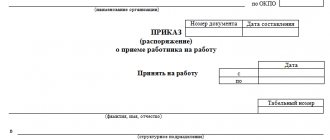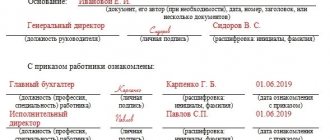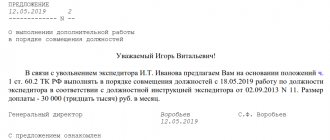Home / Labor Law / Employment / Part-time and part-time work
Back
Published: 07/22/2016
Reading time: 10 min
0
946
Combination and part-time work are the two most common concepts associated with the work activities of working citizens.
When documenting a new employee, there may be confusion about these definitions. Moreover, mistakes can be made even by personnel department employees who have not previously encountered in practice this type of work activity such as part-time work or combination work.
Article 37 of the Constitution states that any able-bodied citizen has the right to choose a profession and occupation at his own discretion. From which it follows that if physical capabilities and qualifications allow, an employee can be involved in the labor process at several enterprises or workplaces at once. No one forbids him to combine two professions or take a part-time vacant position.
- Legislation
- Definition of concepts Part-time job
- Combination
- When combined
What is part-time work
As follows from the provisions of Article 282 of the Labor Code of the Russian Federation, part-time work is the performance by an employee of other regular paid work under the terms of an employment contract in his free time from his main job.
Accordingly, the main features of part-time work are: a separate employment contract and the performance of job duties only at a time when the person is not busy at his main place of work. As a general rule, a part-time worker can work for each employer for a maximum of 4 hours a day. Longer part-time work is possible if a person is free from his main job that day and in other cases listed in Article 284 of the Labor Code of the Russian Federation.
Payment for part-time work is made in proportion to the time worked (Article 285 of the Labor Code of the Russian Federation).
Calculate your advance and salary for free, taking into account all current indicators
Definition of concepts
Part-time job
Part-time work is considered to be work activity that is performed in addition to the main job and in free time from it..
An employee can be hired for a vacant position at an enterprise where he already
works (internal part-time job), and in another organization or enterprise where there are free places (external part-time job).
The employer is individuals (entrepreneurs or ordinary citizens who need the services of an employee), as well as legal entities (organizations, enterprises, institutions, joint-stock companies).
Persons employed part-time are subject to all social guarantees and benefits provided for by local documents and labor legislation for other full-time employees.
To formalize the employment relationship, the employer must sign an agreement with the part-time worker, taking into account all the nuances of his work activity.
For example, the document should indicate that wages will be calculated in proportion to the time worked (usually half the rate provided for a specific position). The contract also directly indicates that the person has received an additional job.
A position given to a part-time employee must be included in the staffing table of the organization or enterprise. And she is assigned a monthly salary with an hourly wage.
As for the entry in the work book, it is made at the request of the employee himself - that is, it may or may not be present in the document. If an entry is made in the book, it includes details of the order according to which the person is enrolled in the working staff.
The law has introduced a number of restrictions on part-time work. They cannot get a second job:
- workers under eighteen years of age (according to Article 282 of the Labor Code);
- workers who are already engaged in work in harmful or life-threatening conditions (according to Article 282 of the Labor Code);
- transport service workers (according to Article 329 of the Labor Code);
- persons in leadership positions (according to Article 276 of the Labor Code).
In addition, this type of work activity may be prohibited by departmental regulations. For example, the ban applies to civil servants, lawyers, judges, members of the Government, and bank employees.
It should be taken into account that external part-time work is available to an employee at several enterprises at once (he can occupy not only two, but also more jobs!). This right is provided for by Article 282 of the Labor Code.
Combination
Combination is considered to be the performance of two or more job responsibilities, as well as the temporary replacement of an absent employee. At the same time, the employee is not released from the main job functions - he does not work in an additional place during his free time from his main work activity. Combining professions is possible only at one enterprise or in one organization or institution - this is an internal type of work activity (with one employer).
The combination is entrusted to persons who have the appropriate qualifications displayed in the work book.
Also, this employee must express written consent to accept additional work functions (the workload increases, but working hours remain the same). It is impossible to master the combination without proper experience and qualifications!
For persons employed in combination, local regulations provide for an incentive additional payment. Its size depends entirely on the collective decision fixed in the collective agreement.
A characteristic feature of such activities is the absence of a contract. Even
In this case, the statement is not written by the employee, since he does not ask to be provided with an additional place of work. The basis for the combination is an order from management, which is also signed by the employee. With this signature, he expresses his consent to accept additional official or professional responsibilities.
The combination can last for a certain period (for example, if we are talking about replacing an absent employee) or be indefinite. In this case, all the terms of the previously signed agreement apply. Records of the performance of dual-employment duties are not entered into the employee’s work book.
Typically, combination is practiced in the following cases:
- To perform parallel activities with similar conditions and specifics at one workplace.
- To perform consistent activities with different conditions and specifics at different workplaces.
- To carry out mixed activities according to the two schemes indicated above.
External and internal part-time work
According to Article 60.1 of the Labor Code of the Russian Federation, part-time work can be internal and external. In the first case, the employment contract for part-time work is concluded with the same employer with whom the main contract was concluded. In the second, the employers are different.
REFERENCE. Concluding employment contracts for part-time work is allowed with an unlimited number of employers (Part 2 of Article 282 of the Labor Code of the Russian Federation). This means that an employee can be both an internal and external part-time worker at the same time.
Who can work part-time
The right to perform part-time job functions (external and internal) applies to all citizens. But for certain categories there are some restrictions. Here it is worth highlighting the following points:
- It is prohibited for minors (under 18 years of age) to work two jobs at the same time;
- it is not allowed to perform labor functions at two jobs with harmful or dangerous working conditions;
- Drivers are prohibited from working simultaneously for two employers (if they intend to perform the same functions related to driving a vehicle);
- there are restrictions (in the form of the owner’s consent) on working in another company in a managerial position;
- Coaches and athletes must also coordinate their outside work activities with the main employer;
- Civil servants with access to state or commercial secrets may receive restrictions on working in other companies.
As we can see, most of the restrictions are associated with the physiological characteristics of the human body (overwork, excessive exposure to harmful factors and substances), or a conflict of interests (combination can cause information leakage to competitors).
Remember, if you are going to work part-time, in order to avoid misunderstandings in the future, it is better to notify your main employer about this.
What is combination
Article 60.2 of the Labor Code of the Russian Federation allows, with the written consent of the employee, to entrust him with additional duties that were not initially provided for in the employment contract. If such work is carried out along with the main work during the working day without increasing its duration, then this is called combination.
There are different forms of combination. So, it is possible to combine professions or positions. For example, a driver performs the duties of a freight forwarder. Or a deputy - the responsibilities of a manager.
IMPORTANT. Professions (positions) filled in a combination manner must be provided for in the staffing table. Without this, problems may arise with the tax accounting of additional payments for performing additional work, as well as with the payment of state benefits due to the employee (see, for example, decisions of the Fifteenth Arbitration Court of Appeal dated February 15, 2012 No. 15AP-15046/2011 and FAS Volga District dated April 12. 11 in case No. A12-11725/2010).
Create a staffing table using a ready-made template Try for free
Another combination option is expanding the service area or increasing the scope of work. For example, a sales manager takes over the work with clients of a colleague during his vacation, or an accountant “closes” an additional area during the illness of his colleague.
In any case, an additional payment is due for the combination (Article 115 of the Labor Code of the Russian Federation). The employer indicates its amount in the proposal to perform additional work. The employee has the right to accept or reject this offer.
To refuse a combination, you need to notify the other party to the contract three working days in advance. Both the employer and the employee have this right (Article 60.2 of the Labor Code of the Russian Federation).
Combination
If you compare part-time and part-time work, what the difference is can be understood if you read Article 60.2 of the Labor Code. It clearly states that combination can be defined as the amount of work an employee does additionally at his own workplace. The employer burdens the subordinate with additional responsibilities without interrupting his main activity.
It turns out that combination and part-time work are very different in this regard. When combining, only with the consent of the employee himself can he be given any other responsibilities. In this case, an additional employment contract is not concluded, and everything is formalized only by order of management.
The difference between a combination and a part-time job is now clear. In the first case, a person can agree or refuse management’s offer, and in the second, if he wishes, he himself looks for a place to earn additional income if he is not satisfied with the salary for his main job.
Any specialist at the enterprise should be aware that no manager has the right to burden him with additional combined responsibilities without obtaining his consent. He can always refuse this. Nowadays there are often situations where an employer tries to work an employee more, but pay only for the main work. To avoid getting into trouble, everyone should study their job description, which contains detailed information about the duties that they must perform.
It is necessary to have a good understanding of the issues of what internal combination and combination are, what is the difference between these concepts. Only after studying all the nuances can you try to find a part-time job or agree to do additional work.
When is it possible to combine and part-time at the same time?
As can be seen from the above definitions, combination and part-time work are not mutually exclusive concepts. This means that the following situation is possible. The employee is a part-time worker (that is, he performs additional work in his free time from his main job, both for the same and for another employer), and at the same time receives additional payment for part-time work (that is, for performing during the working day along with his main responsibilities and additional work for the same employer).
Accordingly, a person will receive a salary for part-time work. Its size is determined in proportion to the time worked and is agreed upon by the parties in the employment contract for part-time work. And for combined work - an additional payment, the amount of which the employer determines independently when he invites the employee to take on additional workload.
Calculate “complex” salaries with coefficients and bonuses for a large number of employees
Main differences
Each of the two listed types of work activity has its own advantages and disadvantages that must be taken into account by both interested parties.
The main differences are as follows:
| Peculiarities | Combination | Part-time job |
| Agreement | is not concluded, the activity is not recorded in the work book | is concluded, the activity is recorded in the work book at the request of the employee |
| Main responsibilities | cannot be removed, work is completed during the working day | not filmed, but additional work is done in free time |
| Work schedule | complete for all positions | incomplete, cannot exceed 4 hours in duration (with a standard 8-hour working day) |
| Admission restrictions | only for medical reasons | available for some categories of workers and professions |
| Documentation | not required | a full package is required (relevant for external part-time workers) |
| Decor | memo, order, additional agreement | statement, order, contract or additional agreement |
| Probation | not installed | installed in individual cases |
| Salary | as an additional payment | in the form of an interest rate taking into account hours worked |
| Vacation period | is not provided | provided simultaneously with rest at the main workplace |
| Termination | at the request of the employee or in connection with the return to work of an absent employee | according to the Labor Code, at the initiative of management, at will, circumstances |
Some categories of workers are entitled to compensation for working in hazardous working conditions. Are you interested in the taxation of bonuses? All the latest information is in our article. Does an employer have the right to fire a pensioner? Find out about this in our material.
Who cannot be a part-time worker
Due to the direct instructions of Article 282 of the Labor Code of the Russian Federation, under no circumstances can you conclude an employment contract for part-time work with a person who is under 18 years of age.
It is also prohibited to engage on a part-time basis persons who will be employed in work with harmful and (or) dangerous working conditions, or in work related to transport or traffic control, if their main work takes place in the same conditions (Article 329 of the Labor Code of the Russian Federation) .
ADVICE. This prohibition applies to both internal and external part-time workers. Accordingly, in such cases, persons applying for external part-time work must be required to provide documents on the nature of their main job.
The head of an organization can be an external part-time worker only with the permission of the authorized body of the legal entity or the owner of the organization’s property, or a person (body) authorized by the owner. These are the requirements of Article 276 of the Labor Code of the Russian Federation.
Only with the permission of the employer can athletes and coaches take part-time jobs at their main place of work (Article 348.7 of the Labor Code of the Russian Federation).
Part-time work is completely prohibited for state and municipal employees (Article 17 of the Federal Law dated July 27, 2004 No. 79-FZ, Article 14 of the Federal Law dated March 2, 2007 No. 25-FZ), as well as other persons who work in government agencies , armed forces, police, courts, prosecutor's office, etc.
In addition, on the basis of Article 51 of the Federal Law of December 29, 2012 No. 273-FZ, the official duties of heads of state and municipal educational organizations, as well as their branches, cannot be performed part-time.
Check the counterparty for signs of a shell company and the presence of disqualified persons
No such prohibitions have been established regarding combinations.
OPINION. Probably, the absence of prohibitions on combination is due to the fact that the relevant work is performed along with the main job duties for the same employer during working hours. This means that the combination does not lead to a violation of the restrictions established in the Labor Code of the Russian Federation on the duration of work of certain categories of persons (minors, drivers, as well as those who work in harmful and dangerous jobs). Also, when combining, there is no conflict of interest, due to which bans on combinations have been introduced for a number of employees and civil servants.
News
COMBINATION OR COMBINATION?
Every individual has the right to additional paid work
So how to distinguish a part-time job from a combination? The terms are very similar to each other and therefore many questions arise about the duration of work and its payment
Let us turn to the Labor Code of the Republic of Kazakhstan:
Part-time work is the performance by an employee of other regular paid work under the terms of an employment contract in his free time from his main job.
Combination of positions - the employee, along with his main work provided for in the employment contract (job description), performs additional work in another vacant position
clause 1 Art. 21. Labor relations arise between an employee and an employer on the basis of an employment contract concluded in accordance with the Labor Code of the Republic of Kazakhstan, except for cases established by the laws of the Republic of Kazakhstan
clause 1 Art. 33. An employment contract is concluded in writing in at least two copies and signed by the parties. One copy of the employment contract is kept by the employee and the employer
clause 3 Art. 33. A person is allowed to work only after concluding an employment contract.
In the absence and (or) failure to properly draw up an employment contract due to the fault of the employer, he bears responsibility in the manner established by the laws of the Republic of Kazakhstan. In this case, the employment relationship is considered to have arisen from the day the employee started work
clause 4 Article 32. To conclude an employment contract for part-time work with another employer, the employee submits a certificate about the nature and conditions of work at the main place of work (place of work, position, working conditions).
In case of part-time work, if the work is carried out with the same employer as at the main place of work, it is necessary to conclude a separate employment contract! An employment contract for part-time work must necessarily contain an indication of the nature of such work, i.e., that the work is part-time
clause 2 Art. 52. An employment contract for part-time work may be terminated at the initiative of the employer if an employment contract is concluded with an employee for whom this work will be the main one
clause 3 Art. 68. The total duration of daily work at the place of main work and part-time work should not exceed the norm for the duration of daily work established by paragraph 4 of Article 71 of the Code (8 hours) by more than 4 hours
When working part-time , the time worked is taken into account, and payment is made for the hours actually worked!
clause 1 Art. 111. Employees who perform in the same organization , along with their main work stipulated by an employment contract, additional work in a different or the same position or the duties of a temporarily absent employee without release from their main job, are paid additionally
When combining the job, the employee receives an additional payment (above the official salary for the main position)!
clause 3. Art. 111. The amount of additional payments for combining positions , expanding the service area or performing (replacing) the duties of a temporarily absent employee is established by the employer by agreement with the employee based on the volume of work performed
When working on the condition of combining positions, the conclusion of a separate employment contract is not required!
Appendix 18 to PP No. 1193. For employees of state institutions and state-owned enterprises who perform additional work within working hours in their main position (profession), an additional payment for combining positions (expanding the service area) is established in the amount of up to 50% of the official salary of the employee. BUT... this additional payment does not apply to heads of government agencies, state-owned enterprises and their deputies
HEALTH BENEFITS
clause 10 Art. 139 Labor Code of the Republic of Kazakhstan. Civil servants supported at the expense of the state budget are provided with a basic paid annual leave of at least thirty calendar days with payment of a health benefit in the amount of the official salary
Health benefits for civil servants are paid once a calendar year when provided with paid annual leave
clause 5 Art. 92 Labor Code of the Republic of Kazakhstan. Employees working under an employment contract for part-time work are granted paid annual leave simultaneously with leave for their main job.
If the duration of paid annual leave under an employment contract for part-time work is less than the duration of leave for the main job, the employer, at the request of the part-time employee, provides him with leave without pay for the days that make up the difference in the length of leave.
Clause 3 of PP No. 1193. The wage fund for employees of organizations is determined from the DO (tariff rate), additional payments and allowances for working conditions, health benefits for the annual paid leave for civil servants in the amount of one DO (tariff rate) , compensation provided for by regulations legal acts of the Republic of Kazakhstan
Health benefits for civil servants are paid depending on the length of working hours. Accordingly, when working part-time, health benefits are accrued both at the main place of work and at the place of part-time work
The combination is carried out within working hours for the main position
.
Based on this, combining a position (expanding the service area) is not the basis for paying benefits for the combined position
How is a part-time job formalized?
An employment contract must be concluded with the part-time employee. It is necessary for both external and internal part-time work (letter of the Ministry of Labor dated 04/26/17 No. 14-2/B-357).
In both cases, when drawing up a part-time contract, the same rules apply as when hiring an employee for the main job. At the same time, the text of the contract must directly indicate that the work is part-time (Part 4 of Article 282 of the Labor Code of the Russian Federation).
In addition, it must be taken into account that in most cases, under such an agreement, the employee will not be able to work more than 4 hours a day. This means that the regime of his working hours and rest will differ from the one that applies to other employees of the organization. The working time and rest schedule of a part-time worker must be fixed in the text of the employment contract (Part 2 of Article of the Labor Code of the Russian Federation).
Draw up and print an employment contract for free
IMPORTANT. For part-time workers, it is permissible not to set a lunch break, since they work no more than 4 hours a day (Part 1 of Article 108 of the Labor Code of the Russian Federation).
Also, in the employment contract with a part-time worker, it is necessary to resolve issues that may arise if this employee is sent on a business trip by the “main” employer (letter of the Ministry of Labor dated 03/05/18 No. 14-2/B-149).
If a fixed-term employment contract has been drawn up, then you need to indicate its validity period and make a reference to Part 2 of Article of the Labor Code of the Russian Federation. It should be stated that the employment contract was concluded for a certain period by agreement of the parties due to the fact that it is a “part-time” contract.
On the basis of the employment contract, an order (instruction) on hiring is issued (Part 1 of Article of the Labor Code of the Russian Federation). It indicates that the employee works part-time. When using the unified form of order No. T-1, this mark is made in the line “Conditions of employment, nature of work”, where it is written: “part-time work” (see Instructions, approved by Resolution of the State Statistics Committee dated 01/05/04 No. 1).
Fill out and print out an order using form No. T‑1 for free
ATTENTION. An order for hiring must be issued for both external and internal part-time work (letter of the Ministry of Labor dated 04/26/2017 No. 14-2/B-357).
A personal card for a part-time worker (unified form No. T-2) must be issued for both external and internal part-time work. In this case, the part-time worker is assigned a separate personnel number, which is used to record working hours and calculate wages.
An entry in the work book of a part-time worker can be made by his main employer upon a written application from the employee himself (Part 5 of Article of the Labor Code of the Russian Federation). If we are talking about external part-time work, then supporting documents must be attached to the application. This could be an employment contract, a certificate from a part-time job, a certified employment order, etc.
Part-time and combination: comparative table
From the above descriptions it follows that part-time work and combination work have little in common. In both options, we are talking about additional work assigned to the employee, which is formalized by order of the employer. The remaining basic characteristics are different:
| Characteristic | Part-time job | Combination |
| Relationship to the place of main work | Can be registered both at the place of main work and with other employers, the number of which is not limited | Issued only at the place of main work |
| Restriction on use | Prohibited for certain categories of workers | There are no prohibitions |
| Linking with main work time | Performed outside of regular work hours. The total duration of work cannot exceed half of the monthly working time standard. | Carried out during main work |
| Functions performed | The place of main work is always different from the main responsibilities. For other employers, they may either coincide with the main ones or differ from them. | They may either coincide with the main ones or differ from them. |
| Drawing up a separate employment contract | Each employer must complete this form. The text must indicate that the work is performed part-time. | Not required |
| Organizational and administrative document | The order of acceptance to work | Order for combination |
| Payment for performing duties | Defined as a salary, the amount of which depends on the time or volume of work actually performed | Installed as an additional payment for additional functions |
| Use of vacations and additional payments for work in the Far North and equivalent conditions | Has its own characteristics | Without features |
| Discontinuation of use | By dismissal, changing the terms of the employment agreement, termination upon expiration | Upon completion of the combination period or ahead of schedule at the request of either the employee or the employer |
| Reflection of information in the work book | Not required, but can be done | Not required |
How is the combination arranged?
The employer must first make a formal written offer to the employee to perform additional work. It indicates exactly what work will need to be done, for how long and for what additional payment.
If the employee does not mind, then he puts a mark of consent on this document and certifies it with his signature indicating the date. Based on this document, an order or instruction is issued (for example, on combining professions or positions; on expanding service areas; on increasing the volume of work). This document reproduces all the same conditions that were stated in the employer’s written offer. The order also provides a link to the specified proposal, in which the employee marked his consent to the combination. The employee must be familiarized with this order and signed.
Compose HR documents using ready-made templates for free
Information about the combination is not entered into the employee’s work book and personal card. An additional employment contract is not concluded.
We are hiring part-time workers
When formalizing an employment relationship, the main thing is to remember that both combination and part-time work are possible only at the request of the employee or with his written consent, if the initiative comes from the employer.
And although the procedure for registering a part-time worker is generally similar to hiring a main employee, there are also some nuances. In the employment contract, be sure to include the condition that the employee is hired part-time. Pay special attention to the points about the volume of work and methods of calculating wages (based on actual time worked, production results, or in accordance with other agreements).
Fill out orders, employment contracts and additional agreements in the Kontur-Personnel program.
To learn more
All these conditions must be reflected in the employment order. You can compose it based on the unified T1 form or develop your own. Neither external nor internal part-time workers need to draw up a new work book. But the employee can make an entry about additional work in it. If the part-time job is internal, then the data is entered based on the application. External part-time workers must provide the employer with a document confirming employment at the main place (certificate, copy of the order, etc.).
Important: be sure to familiarize the external part-time worker with all local regulations relating to his activities against signature.
Termination of an employment contract with a part-time worker occurs according to the general rules:
- at the initiative of the employer or employee;
- due to the expiration of the contract;
- on other grounds provided for by law or agreement.
The basis for terminating an open-ended employment contract may be the employer’s intention to hire a person for whom this work will be the main one in place of a part-time worker (Article 288 of the Labor Code). The employer warns the part-time worker about this at least two weeks in advance.
What is more profitable for an employee: part-time or combination?
What is more beneficial for the employee and the employer must be considered individually. In most cases, part-time work will be more profitable for the employee, since it occurs in parallel with the main responsibilities, and part-time work requires the allocation of additional time for work. Whereas for the employer, it is likely that a separately drawn up contract will guarantee better performance of duties.
Combination involves the employee performing his duties in different areas for one employer, while part-time work involves performing his functions for several employers or for the same one, but under different employment contracts.
07 Aug 2021 stopurist 982
Share this post
- Related Posts
- The right to recourse to a pledged car after being taken by the bank
- Return of Cut-off Products
- Sample characteristics from the student's place of study sample
- Requirements for the placement of parking spaces in blocked housing
Most popular questions
In a conversation about what internal part-time work is, current issues related to this type of labor obligations should be touched upon. First of all, we should talk about the timing of work duties. According to the current law, the parties can enter into either an open-ended agreement or an employment contract, which will establish clear terms for this type of professional activity.
It is important to note that the employee must provide written consent to the working conditions offered by the employer.
Also, many workers are interested in the question of the length of the working day. With internal combination, additional production issues are resolved during the working day . In this case, the employee does not need to work additional time. With external part-time work, additional obligations are fulfilled only in free time . It should be noted that the current Labor Code contains regulations governing the length of the part-time working day. The regulatory authorities have established monthly standards, according to which the work schedule is drawn up.
Next we should move on to the issue of payroll rules. An employee who combines several positions is assigned an additional payment, which is added to the basic salary. The amount of the additional payment is discussed at the stage of drawing up an annex to the main contract. As a rule, the amount of additional payments depends on the volume produced or the quality of fulfillment of labor obligations. Part-time workers receive a separate salary, which is calculated based on hours worked . All details related to the procedure for calculating remuneration are recorded on the pages of the employment agreement or an appendix to this document.
Next, we propose to discuss the question of what position a part-time worker can hold. In accordance with established rules, an internal part-time worker can fulfill obligations corresponding to both one and different professions . Most employers prefer to appoint part-time employees from the same department where the temporarily disabled employee worked. The same applies to external part-time work. Despite the controversial nature of this issue, from a legal point of view, the current law does not contain regulations prohibiting part-time workers from holding the same position at different enterprises.
You should also consider the procedure for thanking or reprimanding employees who hold multiple positions. In case of violation of the company's internal regulations, the company administration may impose penalties on the employee. When a reprimand is issued, this information is entered into the worker’s personal file. It is important to note that such information is not reflected in the work book, except in situations where dismissal is part of penalties. Unlike disciplinary sanctions, information about gratitude for dedicated work and high performance in work can be entered in the work book of a part-time worker.
The fundamental difference between internal part-time and combination is the procedure for formalizing the relationship











